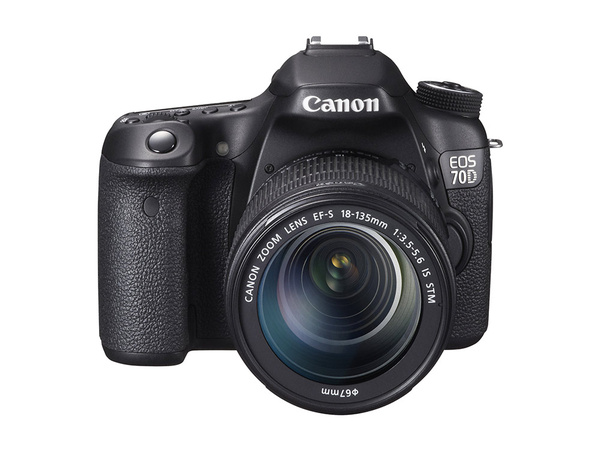Getting to know the camera
When I was just starting to take pictures with a digital camera, the limit of my dreams was the Canon EOS 20D - a “semi-professional DSLR,” as they were called then: a kind of mixture of functionality, reliability and affordability. Years passed, new models came out, and the term “professional DSLR” itself was blurred. But the niche of affordable cameras with serious functionality has not gone away. It’s just that now in it for the most part full-frame cameras are much cheaper in 2013. This is great, but not everyone needs a full frame: someone wants to save on buying cheaper “cropped” optics, someone needs a camera exclusively for shooting on a telephoto lens (in this situation, the crop factor only plays into the hands of the photographer), who The cost of the camera itself is critical. And if there is demand, there will be an offer: In the summer of 2013, the Canon EOS 70D was announced. One look at its characteristics is enough to understand: no, this is not a replacement for the fan-oriented EOS 60D. This is a worthy successor to the legendary “seven” - a solid semi-professional DSLR.
View prices and buy Canon EOS 70D.
Naturally, we could not pass by this news. Today we are starting a big test of the Canon EOS 70D: for seven days we will publish new chapters of testing, sharing our experience shooting with this camera and revealing its capabilities. Stay tuned!
The main features of the model:
- new 20.2-megapixel CMOS sensor APS-C format “Dual Pixel CMOS AF”;
- phase focus sensors located on the matrix;
- DIGIC 5+ processor;
- burst speed up to 7 frames / s;
- 1080p30 video shooting with autofocus and the ability to use an external microphone;
- autofocus system based on 19 cruciform sensors with sensitivity up to -0.5 EV;
- 63-zone iFCL metering system;
- optical viewfinder with a coverage of 98% of the frame area and an increase of x0.95;
- rotary 3-inch touch screen with a resolution of 1040,000 points;
- built-in Wi-Fi module;
- built-in flash with wireless controller function;
- waterproof housing.
Before we go directly to shooting, let's get to know the camera itself. After all, there are more than enough new technologies in it!
|
|
The Canon EOS 70D is the first to use a new 20.2-megapixel sensor with phase detection sensors located directly on it. This is done in order to provide fast autofocus in Live View mode and when shooting video. The pixels of the matrix consist of two photodiodes, which are used for phase focusing. |
|
|
The image processor is responsible for the DIGIC 5+ processor. Let me remind you that in recent years the company managed to achieve impressive results in noise reduction precisely thanks to the proprietary DIGIC processors. |
|
|
And here is another important element - the main autofocus module. It consists of 19 cross sensors. Yes, yes, this is the same module that we saw in the Canon EOS 7D. The center point has a sensitivity of up to -0.5 EV, the rest - up to 0 EV. |
|
|
The camera shutter can handle shutter speeds from 1/8000 to 30 seconds and synchronize with flashes at shutter speeds up to 1/250. The shutter lag after pre-half-pressing the shutter button is 0.06 seconds, with an instant full shutter release - 0.14 seconds. There is a quiet shutter mode - a great thing for reporting photographers. |
|
|
The Canon EOS 70D Pentaprism Viewfinder has more modest features than the EOS 7D viewfinder: an increase of x0.95 versus x1 with coverage of 98% of the frame area instead of 100%. Not every photographer will see the difference in viewfinder size. |
|
|
The camera body is made of plastic. It turned out to be quite massive, but it only benefited ergonomics. The Canon EOS 70D is comfortable to hold with one hand even with a heavy lens. |
|
|
According to the control concept, the EOS 70D is much closer to the EOS 60D than to the EOS 7D. All buttons on the top panel have one clearly defined function: the choice of autofocus mode, shutter operation, metering, setting ISO, turning on the backlight. But a new button appeared: autofocus zone selection. It is responsible for whether the camera will focus on one point, on a group of points or on all 19 points. |
|
|
Video mode is activated by a separate selector located on the rear panel. To start recording, you need to press the button in its center. The same button enables Live View when video mode is disabled. |
|
|
The joystick present in previous Canon models is a thing of the past. Now, instead of him, the naviped is surrounded by a control ring. In the camera menu, you can assign a direct choice of the focus point to the navigation pad, which I did immediately. |
|
|
Of the other interesting buttons located on the rear panel, the Q button should be noted. It brings up the on-screen menu. Even the most ardent opponents of camera control using this menu can reconsider their point of view after one day of shooting on the EOS 70D. Changing the settings using the touch screen after pressing the Q button is a pleasure. |
|
|
Yes, the display on the Canon EOS 70D is not only large and clear. It is also touch-sensitive, with multi-touch support. Moreover, it can be turned literally in any direction. |
|
|
Like any serious camera, the EOS 70D has a separate aperture repeater button - a must-have tool for macro enthusiasts. But if you do not need it, you can assign it, for example, the function of switching on the electronic level. |


